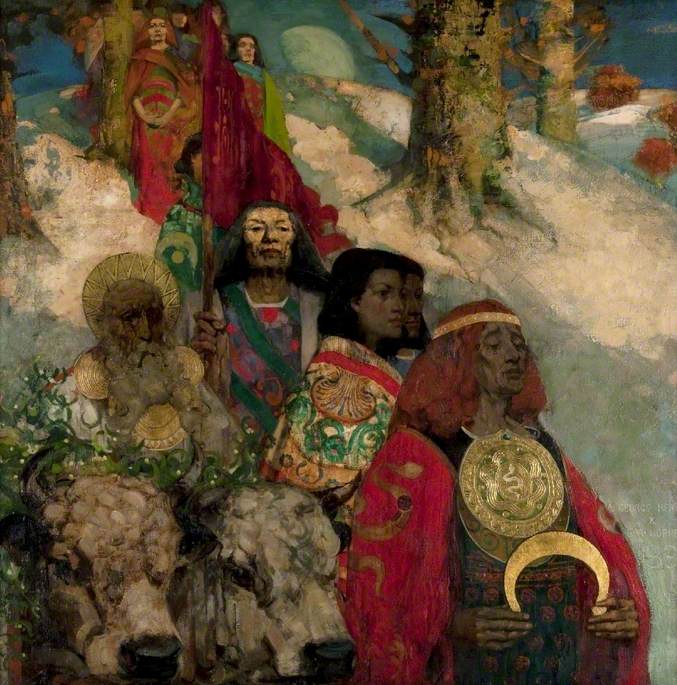Ritual Objects
|
Inspiration: this painting:
The Druids: Bringing in the Mistletoe Edward Atkinson Hornel (1864–1933) and George Henry (1858–1943) Here we see the rite of bringing in the sacred mistletoe, and showing a group of Druids or Celtic priests in richly decorated ceremonial robes and insignia proceeding down a steep hillside in solemn procession. The mistletoe, cut from the sacred oak by a golden sickle held by the chief druid, is ceremoniously received by subordinates in white raiment and borne home reverently on the backs of the white bulls. Mistletoe is significant as a plant revered by the druids for its magical as well as medicinal properties. In the 1890s there was a revival of interest in Celtic art and folklore; the influence of this can be seen in the use of complex intertwining patterns on the priests' robes and also on the pattern work of the frame. Henry and Hornel were members of a group of artists called the Glasgow Boys who, at the end of the 19th century, revolutionized Scottish painting. This painting, dating from 1890, was the first on which the two artists collaborated and is their most daring composition. From The Secret Teachings of all the Ages by Manly P. Hall: He quotes “Eliphas Levi, the celebrated transcendentalist” at length: “[The Druids’] universal remedies were mistletoe and serpents’ eggs ...The solemnity with which mistletoe was cut down drew up on this plant the popular confidence and rendered it powerfully magnetic … Mushrooms, truffles, gall on trees, and the different kinds of mistletoe will be employed with understanding by a medical science … but one must not move quicker than science, which recedes that it may advance the further.” Then he goes on to say: “Not only was the mistletoe sacred as symbolic of the universal medicine or panacea, but also becaus eof the fact that it grew upon the oask tree. Through the symbol of the oak, the Druids worshipped the Supreme Deity; therefore, anything growing upon that tree was sacred to Him. At certain seasons, according to the positions of the sun, mooon, and stars, the Arch-Druid climbed the oak tree and cut the mistletoe with a golden sickle consecrated for that service. The parasitic growth was caught in white cloths provided for the purpose, lest it touch the earth and be polluted by the terrestrial vibrations. Usually, a sacrifice of a white bull was made under the tree.” (p. 43-44) |
©2016-2023 David D'Ostilio - All rights reserved




